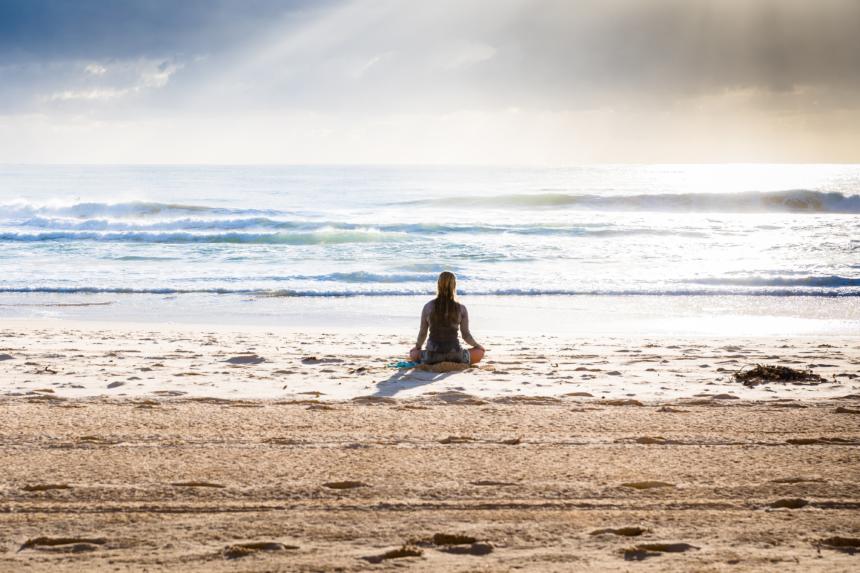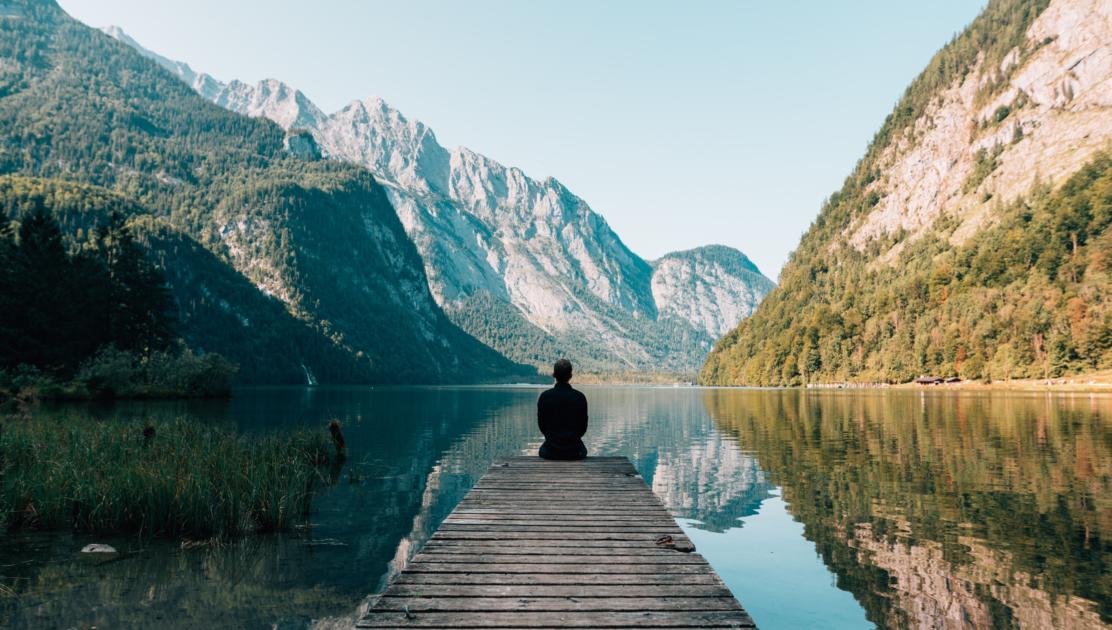Can Nature Experiences Replace Mindfulness?
By Alex TzelnicIn 2016, while trekking in New Zealand’s Fjordland National Park, my wife and I were inundated by three straight days of rain. It made for a grueling trek; our gear was soaked through, our packs weighed down by water, and every part of our bodies was sore. Each day we wondered aloud if it would have been better to have holed up in our hotel in Te Anau with a bottle of wine. And each day the answer was clear: no way. Even soaked and sore, the joy we felt on the journey was undeniable. Being pummeled by wind and rain on the mountain ridge was a strangely fulfilling and meditative experience, a combination of nature and mindfulness. I even made this comparison in my journal:
There was an intimate feeling to it, a reminder of bodily connection, of what the muscles and joints and bones were allowing us to do. It made me think of a Zen retreat. It can be revealing to push yourself beyond your comfort zone, to learn that your reaction to suffering need not dictate your experience. And such complete immersion, life distilled to its essential needs, is liberating. The abstract woes of contemporary life are cast aside.
Robert Pirsig, author of Zen and the Art of Motorcycle Maintenance, famously wrote, “The only Zen you find on the tops of mountains is the Zen you bring there.” It seems I was guilty of doing just that—projecting spiritual meaning onto a nature experience. Of course, I’m not the only one. For centuries, nature has served as both a space in which to pursue contemplative practice and an analogy for the spiritual path. Lama Willa Miller, a lineage holder in the Kagyu lineage of Tibetan Buddhism and the founder and spiritual director of the Natural Dharma Fellowship in Boston, likes to point out that the Buddha himself meditated on the banks of a river for six years before attaining enlightenment underneath the Bodhi tree. “There are so many examples of yogis and monks seeking forests and rivers and lakes as their inspiration for practice,” says Miller. “There’s so much evidence that the natural world was the temple.”
These days, many people believe so strongly in the natural world as temple that they’ve done away with practice altogether. A recent piece in Aeon, “The Healing Power of Nature,” concluded with a quote by a geologist and Colorado River guide named Peter Winn: “For decades, I’ve believed that I’m part of nature, not separate from it or ‘above’ it. Many years ago, I studied Zen Buddhism and learned to meditate. Eventually I found that just hanging out on desert rivers had the same effect as meditation—no stress.”
Is it possible that the contentment I felt on the Kepler Track—and the lack of stress Peter Winn feels on desert rivers—is akin to the goals of contemplative practice? In the era of Big Data, as scientists uncover more about the health benefits of both mindfulness and wilderness, it often seems that way. Doctors are now prescribing both nature and mindfulness to deal with a variety of woes, ranging from PTSD to heart disease. As we optimize our understanding of what constitutes a healthy life, perhaps we’ll find that hanging out on rivers and meditating do ultimately achieve the same end. But such research also invites an array of questions: can a walk in the woods be a replacement for sitting on a meditation cushion? Or by reducing such practices to their ends, and by conflating their benefits, are we, in a sense, missing the forest for the trees?
***

As a Zen practitioner, it can be tempting to wave away this comparison as absurd. Meditation is couched in rich spiritual traditions dating back a couple millenia. How could a nature walk ever replace replace the depth and discipline of dedicated spiritual practice? And yet as someone who loves the outdoors, this idea has a seductive appeal. Could a hike be the most holistic of all activities, providing all the benefits of mindfulness with a healthy dose of exercise and environmental engagement on the side?
The long answer is that there is still so much about the brain, body, nature, and mindfulness experiences that we don’t fully understand. But the short answer is that the act of seeking, whether it’s inner stillness or outer wilderness, is good for you. And new research is showing that they are good for you in remarkably similar ways.
Like the Buddha, let’s begin outdoors. When teaching, Miller likes to employ practices that involve the natural world as part of the meditative process. For example, in sky yoga, one rests the gaze on an open sky. When the thoughts start to wander, one brings one’s mind back to the immediacy of the sky in the visual field. “When we’re in a wild environment the senses come alive, and the power of the natural world draws us into it without a lot of effort,” says Miller.
In the scientific community, this kind of environmental absorption is known as “soft fascination.” Rachel and Steve Kaplan, environmental psychologists from the University of Michigan, have found that observing “soft, fascinating stimuli” in nature has a restorative effect on attention. Normally, when our brains are tasked with a specific problem, we are using “directed attention,” which results in mental fatigue. In contrast, the Kaplans’ refer to our state of mind in nature as one of “effortless attention.” As Miller phrases it, “The natural world presents us with novel stimuli, and that novel stimuli is often unique and beautiful and invites us to rest the mind on that stimuli.”
The similarity of the language used by the Kaplans and Miller is striking, and highlights the role attention plays in our overall well-being. Our ability to focus seems directly related to the demands we place on our brain, and the opportunities we give it to rest and recover. But what about when our attention is neither directed nor effortless? What happens when we’re just doing nothing?
When we are surrounded by conceptual stimuli, with no specific task to accomplish, our brains enter what is known as the “default mode network.” Cortland Dahl, a researcher at the Center for Healthy Minds at the University of Wisconsin, explains that the default mode network is linked to self-referential thought patterns. “It turns out that what usually is going on, a little depressingly, is that we are thinking, and we are usually thinking about ourselves,” says Dahl. In cognitive science, this pattern is known as “brooding,” or “morbid rumination.” It is a state of mind often linked to depression. In the brains of meditators, however, the default mode network is less active, and other areas of the brain, specifically those in the prefrontal cortex related to heightened awareness and bodily states, are more active. So too in nature. Gregory Bratman, a researcher at Stanford University who studies the psychological effects of urban living, has found that walking in nature can interrupt our tendency to brood.
In nature, Dahl theorizes, “Because you’re doing something physical and you need to navigate your terrain, you need to be more attuned to the world of the senses,” while at the same time “letting go of any demanding cognitive tasks.” He continues, “There are forms of meditation where you’re also doing that. You’re not trying to concentrate, you’re not trying to contemplate something, but you’re releasing attentional focus and resting in an open receptive state.”
The prefrontal cortex, which has been called the command center of the brain, seems to be integral to this open state. University of Utah researcher David Strayer has studied the “three-day effect,” in which participants who spend three days in the wilderness return with much improved scores on tests of cognitive function and creativity. He hypothesizes that time in nature gives our prefrontal cortex time to recover, and EEG readings of people walking through green spaces support this theory. Harvard neuroscientist Sara Lazar has conducted studies that suggest that long-term meditators have increased gray matter in the prefrontal cortex. In one of her studies, changes in brain volume were seen in just eight weeks of meditation compared with a control group.
Does this mean nature and mindfulness experiences are interchangeable? Not necessarily. ”It may not be that they’re substitutable in the way that economists talk about substitutability, in terms of trade-offs,” says Kathleen Wolf, a researcher at the University of Washington College of the Environment. “It may be that different people, different personalities, different bodies, metabolic or physiological makeups, resonate to different strategies.” From this perspective, one might think of both wilderness and mindfulness as part of a well-balanced spiritual diet. In any case, the evidence is hard to refute: if one’s goal is to enter into a receptive state in which awareness is heightened, brooding is interrupted, and the command center of the brain is restored, it seems either a walk in the woods or meditation will do.
***

Thus far we’ve been focusing on outcomes. Focusing on the ends can be a productive; it can provide a method for comparison, and it can help publicize a beneficial lifestyle choice. “We are a culture that is seeking modalities for living healthy, happy lives,” says Miller. “The intention of the Buddha’s teaching was to alleviate suffering, and if the practices of being in the natural world or mindfulness help alleviate suffering for some people, and if the only way they will accept those practices is if they are presented secularly, I don’t see the problem with that.” Perhaps nature and mindfulness, or simply mindfulness practices grounded in nature, can even be a gateway towards a deeper spiritual practice.
But focusing on the ends can also be reductive, for meditation is a practice that places a remarkable emphasis on the means. “Zen is the ‘spirit of the valley,’ not the mountaintop,” wrote Pirsig. It is not necessarily about where we end up but how we get there.
“We often walk in the woods for enjoyment and perhaps some exercise and fresh air—which is all very positive and can help us feel more balanced,” says Deirdre Eisho Peterson, the founder of the Red Rocks Zen Circle in Sedona, Arizona. “But we generally do this with the expectation of a positive experience.” David Strayer echoed this sentiment in a recent piece for National Geographic. “At the end of the day,” writes Strayer, “we come out in nature not because the science says it does something to us, but because of how it makes us feel.”
Meditation, conversely, is something many of us do regardless of how it makes us feel. “Meditation is about the clear seeing—whether what we are seeing or experiencing is something we find pleasant or unpleasant,” explains Eisho. “It’s about seeing our thoughts, and starting to free ourselves from the dominance of compulsive thinking. It’s about watching everything arise, and then pass away, so that on a deep level we come to know impermanence. Meditation practice gives us something that endures long after we come off the cushion, and I don’t believe that a nature walk has the same cumulative and long-term ability to free us.”
One might be able to achieve a state of no stress while hanging out on rivers, but what about the rest of the time? If the benefits of nature are only accessible in nature, then it is conditional. In meditation practice, one seeks an openness and insight that is unbound by place. Whether or not that is achievable is something that research may not be able to uncover. And whether or not everyone who practices mindfulness shares this intention is debatable. But Eisho’s message is the same regardless: it is not the arena, but the activity that counts.
To clarify this point, Eisho relates the Zen koan, “The Oak Tree in the Garden”:
A monk asked Master Joshu: “What is the meaning of Bodhidharma’s coming from the West?”
Joshu replied, “The oak tree in the garden.”
The monk in the koan, Eisho explains, is displaying his own separation from understanding through his question (which can be taken to mean, essentially, “What is the meaning of Zen?”). By invoking the oak tree in the garden, Joshu is pointing out that there need not be any separation between student and realization, between oneself and the nearby tree, between the mountaintop and the valley.
“When we open ourselves fully to this oak tree, and to whatever is before us, we are in an intimate place of meeting our experience, and our separation is healed,” says Eisho. “This can happen with the oak tree, but it could happen with a plant in the windowsill, a cup of tea, the beloved pottery dish on our dresser, or in a smile with another person.”
In other words, practice is portable, mountains are not. “We can find that intimate place of meeting in nature,” says Eisho, “but that is not the only place.”
Alex Tzelnic is a writer and Zen practitioner living in Cambridge, MA. His work has appeared in Tricycle: The Buddhist Review, The Rumpus, and Killing the Buddha.
Photos courtesy of Unsplash

I like this piece. It is also true that Prophet Mohammad determined a long time ago that mountains are not portable. If you wish them included in your practice, you port your practice to them.
The open concepts of being in “nature” and being in “mindfulness” seem to be compared or “rated” by this article. I’ve been at Garrison several times, even taking refuge with Yongey Mingyur at a retreat and being with the scientists who have been doing many studies of meditation. Like most of us, I love being outdoors or “in nature” and as a teacher of Mindfulness-Based Stress Reduction for twelve years, I surely value and practice “mindfulness”
I have two distinct observations about this article.
1. Our dualistic world too frequently urges us to “compare” or “rate” things. What happened to “both and?”
2. As one who has taken many inner-city children on camping outings, I know that going to “Camp”
going on hikes, etc.l and most certainly being able to travel to the scenic places mentioned in the article is reserved for the very rich, or at least for the typical suburban “well off” family!
At times, Buddhism feels very expensive for those who cannot afford to travel to retreats at beautiful places like Garrison and more. I realize that it takes money to keep these places going. But it takes
LOTS of money for the majority of “poor people” to “be” in “nature”. Many (but not “most” of us have chosen to live away from cities and suburban areas…some of them also poor.
I’m surprised to receive such an article from Garrison Retreat Center!
Most sincerely,
Judith Simpson
Thoughtful writing. I resonate with nature and find I am impacted by my surroundings, w/ that said, mindful practices help move thru many environments. Txs for sharing the post!